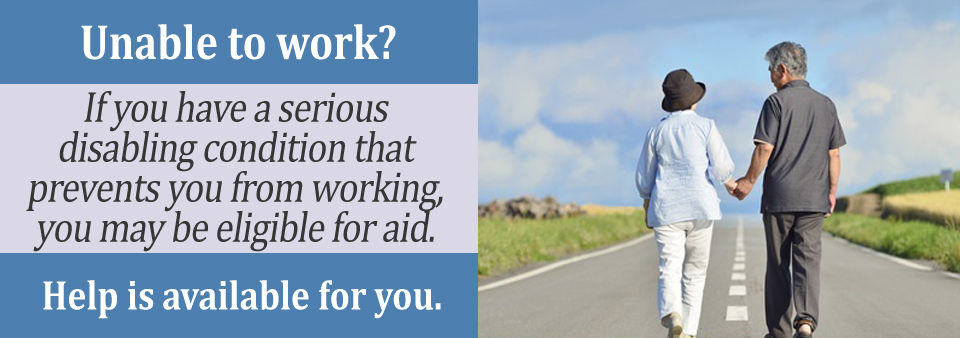The Social Security Administration requires you to meet the specific qualifications and requirements under law, not necessarily if you believe you are disabled or even if your doctor labels you as disabled. The SSA's Disability Determination Services (DDS) will evaluate your claim or appeal to establish if you meet the SSA's definition of disabled. This means you must be unable to to engage in substantial gainful activity (SGA) due to a medical condition. This needs to continue for at least twelve months.
The following are the five things the Social Security Administration takes to determine if you should receive Social Security Disability Insurance. Through the disability determination process, your work ability, severity of your condition, if your condition is recognized by the SSA, if you can do past work, and if there is any other work you can do will all be examined. If you are found to meet the SSA's requirements in these sections, then you may be determined as disabled.
How to Get On Disability
Before determining the steps to determine if you qualify for Social Security disability benefits, you may be wondering, how to get on disability. There are a couple of qualifications you need to meet to get on disability.
The first way in determination that is that you need to have a disability that is serious enough that you will be out of work for at least 12 months.
Conditions like arthritis, cancer, herniated discs are common severe conditions that could force someone to be out of work for at least a year.
If you can no longer work because of your condition, you have a much better chance of getting on disability than someone who can continue to work full time despite their disability.

The second way to determine if you can get on disability or not is that if you have worked long enough to qualify. Since Social Security Disability Insurance (SSDI) is for individuals who at one point could work full time, but now can no longer because of their disability.
In order to get on disability, you not only have to meet the medical parameters set by the SSA, but you also need to have enough work credits. Each year that you earn money and pay FICA taxes, you receive work credits from the SSA.
The amount of work credits you have is determined by your age and how long you have worked. In 2025, you must have earned $1,810 to earn one work credit. You are eligible for up to four work credits per year for how long you have worked. If you meet both the medical and work parameters outlined for the SSA, you may be approved for disability benefits. This is because meeting these two criteria is two of the most important and influential signs your disability will be approved.
How Does Disability Work?
When someone is approved for Social Security disability benefits, they may wonder how disability works. Once approved you will most likely receive either Social Security Disability Insurance (SSDI) or Supplemental Security Income (SSI).
In rare cases, an individual can receive both SSDI and SSI benefits at the same time. How much SSI and SSDI pay together will vary based on your case, and you will receive your disability benefits in monthly installments that will go to your direct deposit.
How much you receive from disability is dependent on the severity of your disability. You will also be entitled to back pay, you will receive more back pay if it took you longer to get approved.

Once you are on disability, you can use your monthly installments for basic day-to-day necessities like groceries, transportation, things around the house, etc.
If you are a disabled worker on SSDI and you have children under the age of 18, they may be entitled to benefits under your record.
On average, disabled workers on SSDI can earn up to $1,620 per month, while disabled individuals on SSI can earn up to $967 per month. You have the option of contacting the SSA if you have any questions regarding your payments. You can call the SSA toll-free at 1-800-772-1213.
#1: Are You Working While Applying for Social Security Disability?
Social Security Disability is meant specifically for those people who are unable to work. It provides payments to those who are otherwise unable to fulfill their work duties due to their disability.
Therefore, if you are currently working and earning enough to support yourself, you will probably not qualify for disability. The SSA does not consider those who are able to work as “disabled.”
Though the income threshold may change from year to year, in 2025, if you earn more than $1,620 a month, you cannot qualify for disability. If you earn less than this, you may qualify under the program and can move on to the next step.
#2: How Severe Is Your Disabling Condition?
In order to qualify for Social Security Disability, your condition must be severe enough to restrict you from working. It must “interfere with basic work-related activities,” according to the SSA.
Disabled individuals are usually unable to work, or they are unable to complete the tasks they normally would have prior to their disability. If your condition is severe and you are unable to do your job, the Social Security Administration may label you as disabled, and you may qualify for disability.

#3: Is Your Condition Recognized By The Social Security Administration?
You may find it a bit shocking, but the fact is, not all medical conditions qualify for disability insurance, even if they seem severe enough to you. You may be thinking to yourself then, what conditions qualify for disability? The Social Security Administration has a Listing of Impairments resource that lists all of the major body systems that the Administration recognizes as being disabling.
If your condition is listed in the SSA’s Listing of Impairments, then you can get disability benefits. You will, however, need to meet the specific requirements of the condition required by the SSA.
For example, you may need to have the symptoms listed or the limitations of your condition outlined by your doctor.
If your condition falls under one of the disabling conditions that automatically qualify for disability, you do not have to go on to the fourth or fifth step.
The Social Security Administration then determines if your case is a “compassionate allowance” case, in which certain cases are qualified as soon as the diagnosis is confirmed, or if your case is a quick disability determination case, where a computer program screens the information provided and makes a decision of its accuracy.
#4: Are You Able To Do The Work You Used To Do?
If your condition does not fall under one of the Listing of Impairments specifically, you need to work through the final two steps to get disability benefits.
In this case, you need to show that the condition you have is severe enough to limit your ability to work. The Social Security Administration is trying to determine if you qualify for disability insurance based on your ability to work.
If your condition is severe enough that it interferes with your ability to do the type of work you did previously, then you can move on. If not, then you are not disabled in the eyes of the SSA.
#5: Can You Do Other Work?
The final qualification for receiving Social Security Disability Insurance is to document your ability to do other types of work. If you are unable to do the work you used to do, the Administration wants to learn if you can do any other type of work, such as with changes made to the way you work.
In this area, the Administration looks at a variety of factors to determine if you may qualify including:
- Your medical condition
- Your age
- Your education
- The type of past work experience you have
- Any type of transferable skills that could follow you to a new position.
If you are able to do other types of work, taking these things into consideration, you are not disabled.
Bonus Step - Medical Vocational Allowance
In some cases, if your medical condition does not meet the standards to receive disability benefits according to the Blue Book guidelines, you could still qualify under a medical-vocational allowance.
The medical-vocational allowance examines whether or not you are physically and mentally able to perform the duties of your job given your condition. The Social Security Administration will take into consideration your age, education, work history and experience, and your residual function capacity (RFC) to determine if the medical-vocational allowance is right for you.
The SSA will look at your ability to perform the physical demands of a job, including the ability to sit, stand, walk, lift and carry items, reach for things, or bend over.
The mental demands considered include being able to read, remember, follow directions, and communicate. The RFC is a measurement of the maximum amount of work you are capable of performing given the limitations of your condition. If you can sit but not stand, then you would not be considered to be disabled, but if you are found to be unable to adapt to any kind of work then you might be eligible for disability benefits under the medical-vocational allowance.
If You Determine You May Qualify for a Medical-Vocational Allowance
The medical-vocational allowance usually does not come up until you apply for Social Security disability and are initially denied benefits. However, if you structure your application in terms of the residual function capacity, with detailed explanations from your physicians about how your condition prevents you from performing the demands of your job, then the chances of receiving benefits will increase.
The SSA will look at your work history and work experience to determine what kinds of tasks you have performed in the past and whether you might be able to perform those tasks now, given your condition. If you suspect that you will not qualify for benefits based on the Blue Book’s guidelines, then think about your work history and how your condition would prevent you from performing those tasks.
In this case, it is important to not only consider your condition but the side effects as well. Does your medication make you too drowsy to operate machinery or remember important information?

Does your condition cause you pain that would distract from your ability to work? When completing your application, make sure that you take time to explain the physical limitations of your diagnosis as you break down your condition.
Your physician should be able to explain what you are capable of doing and what you are not capable of doing in the report, and even though the SSA will go through its own process to determine your limits and abilities, it is a good idea to present as much information as possible upfront.
Each case is different and side effects impact people in different ways. The Blue Book contains general information about medical conditions, but the SSA won’t know the specifics of your situation unless you make your physical and mental limitations crystal clear.
You Could Earn Up to $4,018 Per Month. Find Out if You Qualify Today!
Qualifying for Social Security Disability can be a long process. The process can be very limiting, especially for someone who simply cannot go to work. It is recommended that you get additional advice from a Social Security disability advocate or lawyer to determine if you qualify or help you to fight a denial you may have received.
If you meet the criteria listed in the criteria above, you will likely receive the disability benefits you need.